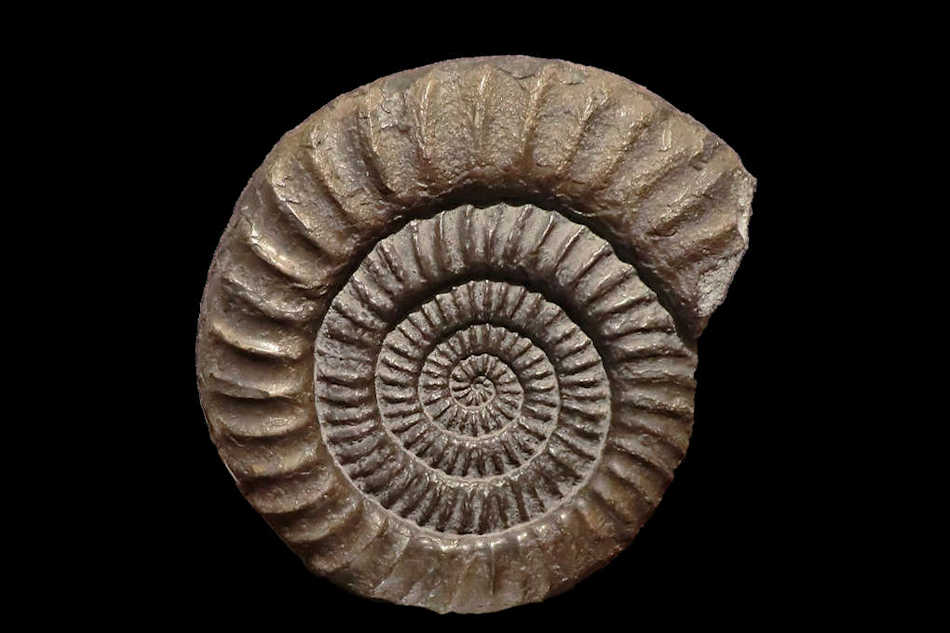Biography: Mary Anning
The Pioneering Female Paleontologist
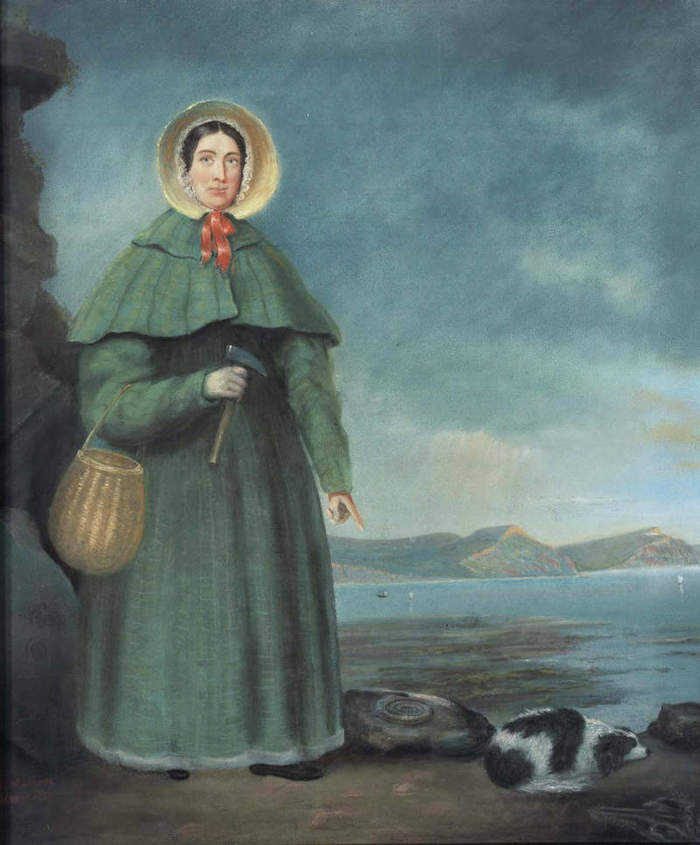
This portrait shows Mary Anning decked out in middle class Georgian clothing of the time. This would have been the most formal outdoor wear Mary had. According to Eleanor Emma Warings' writings, Mary would have been more plainly dressed while fossil collecting. The Golden Cap outcrop is behind her in the distance. It also shows Mary Anning's dog named Tray. Unfortunately, the fluffy fossil hunting companion was killed in an 1833 cliff fall that almost killed Mary Anning. (Public Domain)
Summary Points
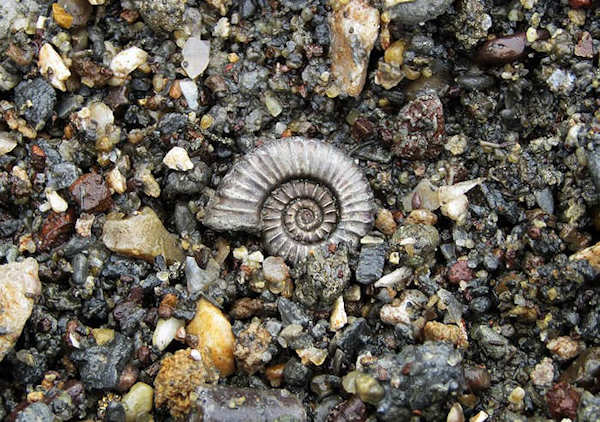
A small pyrite Ammonite found on the beach below Black Ven, between Lyme Regis and Charmouth in Dorset. Image Credit: Partonex. (CC BY-SA 4.0)
At the age of 12, Mary and her brother discovered the first nearly complete ichthyosaur.
In 1823 she discovered the very first nearly complete plesiosaur.
Among her other discoveries include many other nearly complete plesiosaurs and ichthyosaurs, the first pterosaur outside of Britain, and was pinnacle in the interpretation of coprolites (fossil poop).
Mary and her fossil hunting friends would draw fossil diagrams using reconstituted fossil belemnite ink.
Being a female, she was largely ignored by mainstream science. However, many famous naturalists and geologists would visit her at the fossil shop to discuss paleontology and purchase her fossils.
Mary had a close-knit network of other female paleontologists, who were also mostly ignored by scientists of the time.
The Life of Mary Anning (1799-1847)
Birth
Mary Anning was born into a poor family at Lyme Regis in 1799. Mary and her brother Joseph were the only two children to survive childhood. According to accounts, Mary barely survived it! At 15 months old, her mother's friend was carrying her through a horse show when a sudden storm appeared. Among those taking shelter under a tree were 3 of her siblings. Lightning struck the tree, killing everyone but Mary Anning.
Lyme Regis Fossils
The French revolutionary wars and Napoleonic wars in the early 1800's caused wealthy British to avoid mainland Europe for vacations. Instead they traveled to seaside towns for holiday. These towns, such as Lyme Regis, became popular summer destinations. Lyme Regis was also popular because it sits right in the middle of the Jurassic Coast, along the Blue Lias Formation. Tourists would flock here to hunt for and also purchase fossil ammonites as curious souvenirs.
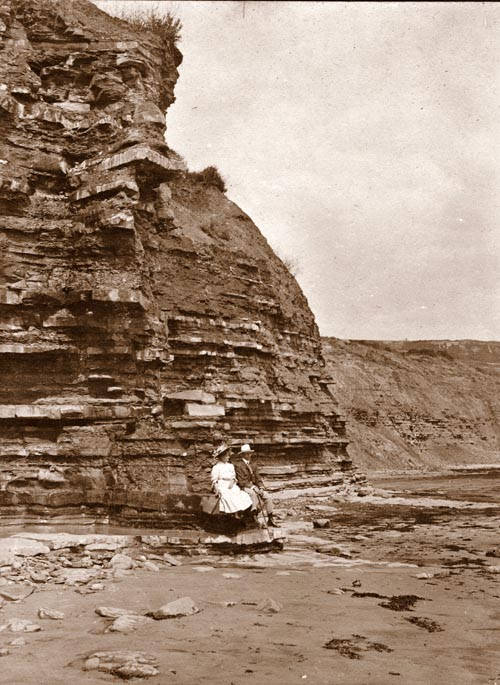
This is a picture from 1909 of a couple sitting on the Blue Lias Rocks on the East Beach at Lyme Regis. The Blue Lias Formation contains numerous Jurassic fossils, including Ammonites and Belemnites. This image is from The Freshford - Charmouth collection.
The Anning Fossil Business
Mary Anning's father, Richard, was a carpenter and in financial debt. Like many other locals, he collected and sold fossils to supplement his small income. At a very young age, Mary and her brother Joseph would accompany him on collecting trips, learning how to search, identify, and remove fossils from the Blue Lias cliffs that are exposed around Lyme Regis and Charmouth. The fossil business consisted almost entirely of ammonites and belemnites, but occasionally crocodiles, marine reptiles, and fish were found.
Mary Anning's father died when she was only 11, and their mother, Mary (Molly) Moore, took over the fossil business. Mary and Joseph would hunt the shores for fossils to re-supply the business.
Discoveries:
First Scientifically Described Ichthyosaur
They soon made major discoveries. The first was in 1811 when Joseph found a large ichthyosaur skull. Mary eventually found the rest of the skeleton. After months of painstaking excavation and preparation, a large 15-foot skeleton was unveiled. This was the most complete example of an ichthyosaur yet found. It was sold to Sir Everard Home of the Royal Society of London. He published a paper on this animal, which was the first ever scientific description of an ichthyosaur. The paper is very confusing, as this was years before Darwin's theory of evolution and scientists were still trying to make sense of animal remains encased in stone. There is no mention of the discoverers, Mary or Joseph, in the paper, because science at that time was reserved for the upper class.
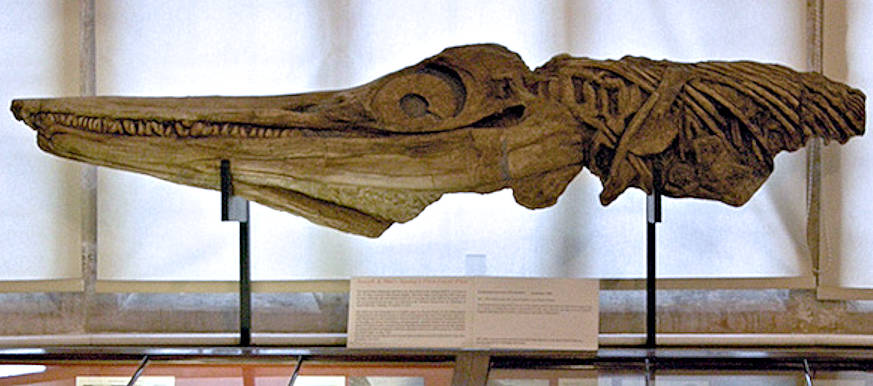
This is a cast of the Ichthyosaur skull and part of the skeleton that Joseph and Mary found in 1811. Also not shown here are numerous vertebra making the specimen over 15 feet in length. It's now classified as Temnodontosaurus platydon. This cast is on display at the Lyme Regis Museum. The original is in the British Museum of Natural History in the marine reptile hall.
Joseph got a job as an upholsterer to help support the family, and began to fossil hunt less and less, making Mary the family's main fossil collector. By the 1820's Mary had found more ichthyosaurs; many of which were described in leading scientific papers by prominent naturalists. She also began studying the fossils, their anatomy, and reading publications, learning the trade of the new science called "paleontology."
First Complete Plesiosaurus
In 1823 Mary found the first ever nearly complete Plesiosaurus skeleton. It was so spectacular that the leading naturalist, Charles Cuvier, assumed it was fake until he was able to personally examine it. This discovery made Mary Anning famous and people would visit Lyme Regis just to meet her. Even still, her name was left out of many of the scientific publications in which her fossils were described. Since the discovery she found a second nearly complete plesiosaurus and additional Plesiosaur specimens, some of which are on display at the Natural History Museum in London.
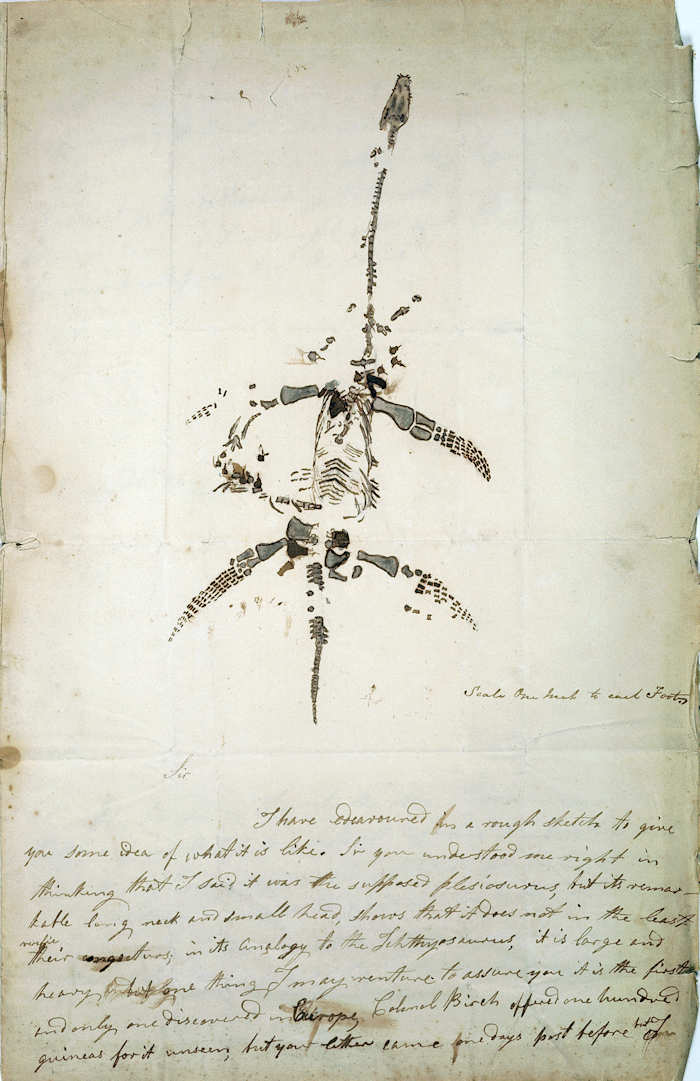
Mary Anning's letter from December 26, 1823 discussing her Plesiosaurus discovery. (Public Domain).
Fossil Poop
Mary Anning is also responsible for the interpretation of fossil poop. She would frequently find lumpy objects in the gut region of ichthyosaurs. Upon breaking them open, she would find fish bones and scales. William Buckland, a famous geologist that frequented Lyme Regis, used Anning's observations to deduce these objects were in fact fossil poop, which he coined "coprolites." Buckland even credited and spoke highly of "Miss Mary Anning" in his Coprolite paper.
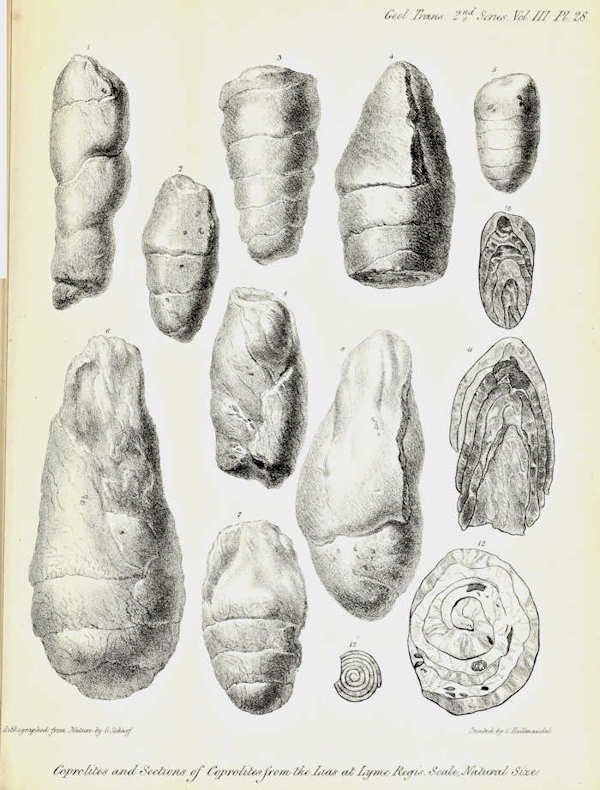
These are drawing of fossil poop from Bucklands paper that Mary Anning found. This is plate 28 from Buckland, W. (1835): On the discovery of coprolites, or fossil faeces, in the Lias at Lyme Regis, and in other formations. Transactions of the Geological Society of London, second series 3: 223-236. Image from a digitized copy at the Biodiversity Heritage Library.
First Pterosaur outside of Germany
Another famous discovery is the first ever Pterosaur found outside of Germany. In 1828, she found the jumble of bones of a headless creature and knew they were very different than any previous fossil she had found. She showed the fossil to William Buckland, who recognized the bones as belonging to a pterosaur. Mary's mentor and collecting friend, Elizabeth Philpot, also found the skull of a pterosaur. Buckland purchased Mary's specimen for study and it eventually worked its way to the Natural History Museum in London, where it is on display today.
What's a pterosaur? Learn about Pterosaurs here.
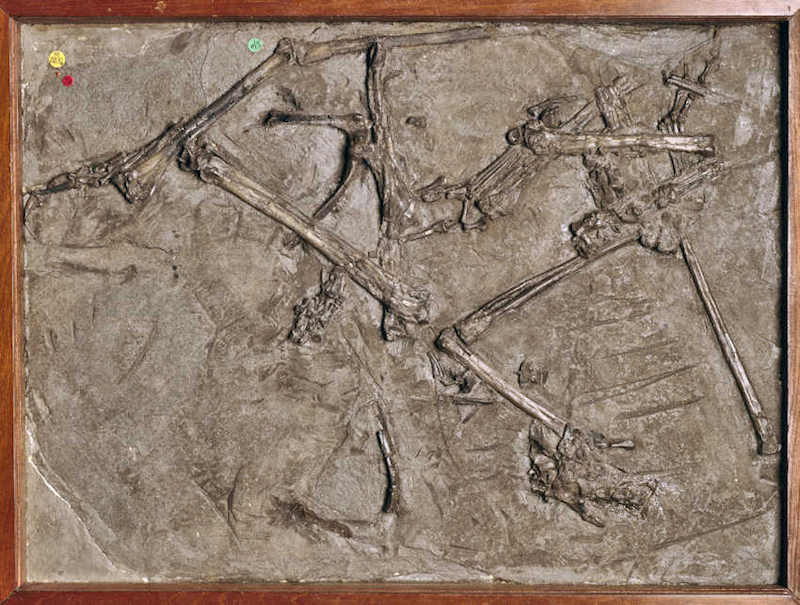
Mary Anning found the first Pterosaur outside of Germany. Her holotype specimen is called Dimorphodon macronyx and was found in the Blue Lias of Lyme Regis. This is specimen number PV R 1034 at the Natural History Museum, London. Image from the digitized collection of the British Museum - Credit: The Trustees of the Natural History Museum, London (CC-by-4.0).
Fossil Ink
One interesting discovery was fossilized ink from belemnites. Ammonites and Belemnites are the most common fossils found in the Blue Lias along Lyme Regis and Charmouth. Mary was the first to identify ink sacs that belonged to belemnites, showing they were closely related to squid. Mary's fossil hunting friend and mentor, Elizabeth Philpot, took it a step further and mixed the fossil ink with water to reconstitute it. Mary, Elizabeth, and other fossil friends such as Anna Maria Pinney soon used this reconstituted belemnite ink to make drawings and diagrams of their fossils. That's pretty committed if you ask me!
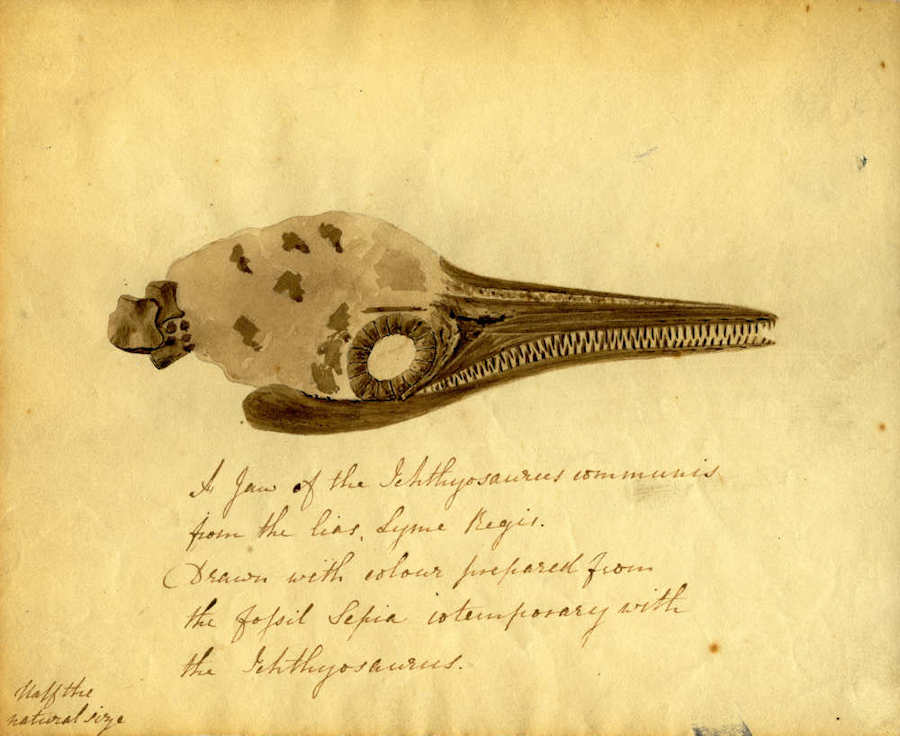
This is a sketch of an ichthyosaur from part of a letter from Elizabeth Philpot to Mary Buckland from 1833. Philot's sketch is made from fossil belemnite ink. Elizabeth Philpot and her two other fossil collecting sisters had a close-knit friendship with Mary Anning. A collection of her letters are housed at the Oxford University Museum of Natural History.
By 1826 the Anning family had raised enough money selling fossils to purchase a house on Broad Street. They left their original house that was left partially destroyed by a storm in 1824 (which is now the location of the Lyme Regus Muesum) and moved into the new house. They turned it into a fossil shop called "Anning's Fossil Depot," and kept impressive fossil displays in the large storefront window, including a large ichthyosaur.
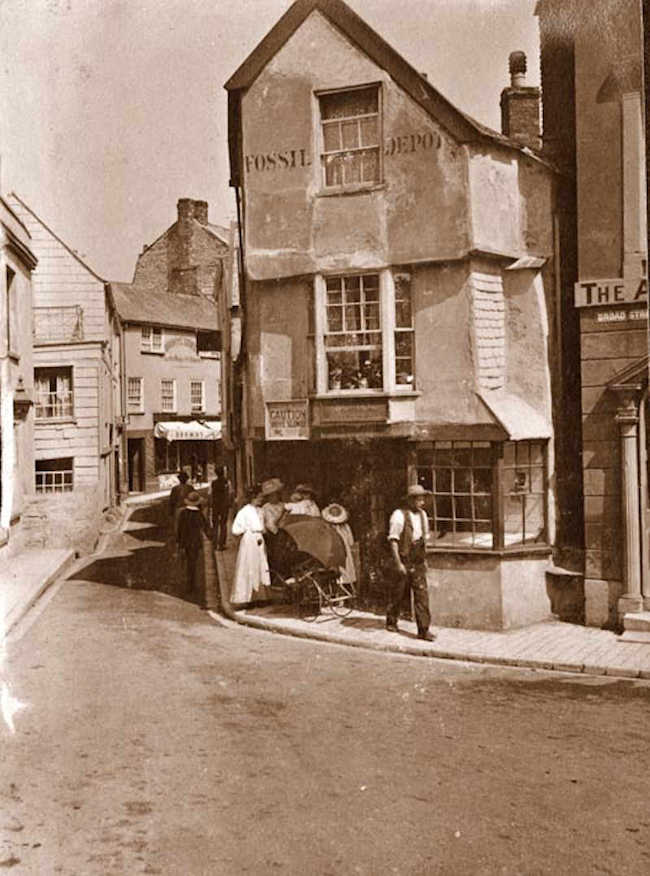
This is a photo of the 'Old Fossil Shop' on Broad Street in downtown Lyme Regis. This was not Mary Anning's fossil shop, as it was further up Broad Street. This particular shop became a famous fossil shop after Mary Annings death. It was run by the Dollin family for many years. This image is from 1909, long after Mary Anning and the Dollins. The building was destroyed in 1913 to widen Broad Street. This image is from The Freshford - Charmouth collection.
Mary Anning and the Scientific Community
Being a woman in 1800's Britain gave her few rights, and although she was well known in the scientific community for her fossils and her knowledge, she was not allowed to join any professional societies. However, many prominent geologists and naturalists of the time would correspond with Mary and visit her at her fossil shop. She even took Richard Owen on a guided fossil hunting tour of the Blue Lias, and in 1844, the King of Saxony visited her shop. These prominent scientists used Mary Anning's fossils and knowledge in many publications, but often made no mention of her.
A few exceptions include Louis Agassiz, a famous naturalist who visited her in Lyme Regis. He named two specimens after her, two fish, called Acrodus anningiae and Belenostomus anningiae.
Geologist Henry De la Beche, who was friends with Mary, painted his famous diorama "Duria Antiquior, a more ancient Dorset" based on fossils she had found. This painting is the first ever depiction of reconstructed prehistoric life and started a new genra called Paleoart. The painting was widely used in scientific circles and prints were sold by Henry to raise money for Mary Anning.
Also, because of her important discoveries and knowledge, William Buckland, in the late 1830's, convinced the British Association for the Advancement of Science to give her a small, yearly stipend to fossil hunt.
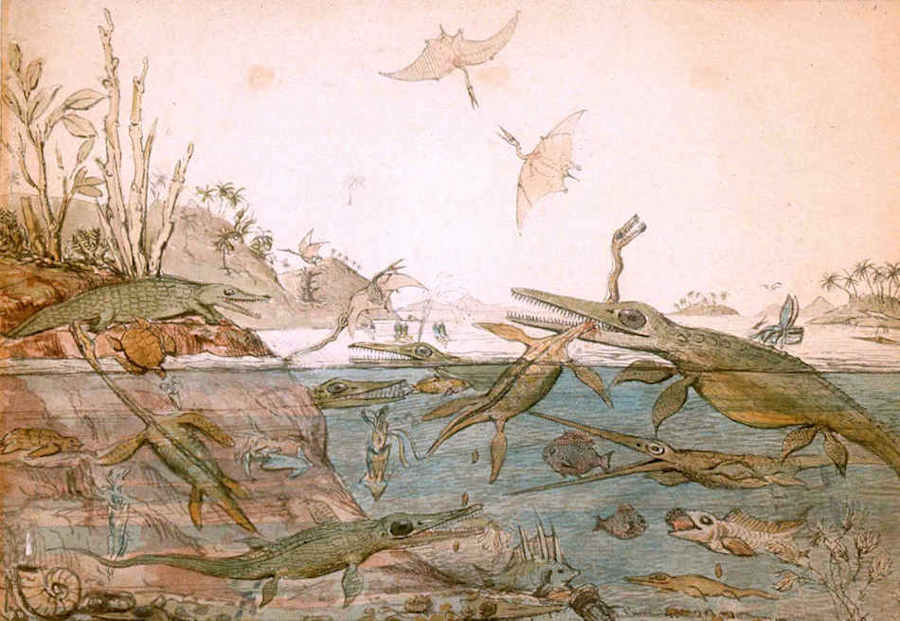
Duria Antiquior, a more ancient Dorset, was a watercolor painted in 1830 by Henry De la Beche. This is the first ever a pictorial representation of prehistoric life. It coined an entirely new genra called Paleoart. The painting is based from fossils found by Mary Anning around Lyme Regis. The painting was widely used in scientific circles and prints were sold by Henry to raise money for Mary Anning. In the image one can find a number of Mary Annings fossils, including an ichthyosaur eating a plesiosaur, a plesiosaur eating a pterosaur, a sea turtle eating a belemnite, a crocodile, and ammonites just laying around (I suppose he didn't know how to interpret those). (Pubic Domain)
Death
Mary Anning never married, possibly because she was always immersed in fossil hunting. She did, however, have many friends. She would often fossil hunt and correspond with other women of science who were ignored by professionals. Mary developed breast cancer in 1845. The Geological Society paid for her treatments, but to no avail; she died in 1847. She was buried at the Lyme Regis Parish Church. After her death, the Geological Society paid for and dedicated a large stained-glass window at the church for Mary Anning.
Today, Mary Anning is widely recognized as one of the pioneering women in paleontology. Her contributions to the field, showing there was diverse, complex, and totally different life on earth before us, helped shape and guide the new and fledgling field of paleontology.
Lyme Regis Today
Today, unlike the stigma in the United States, the United Kingdom encourages safe and responsible amateur fossil collecting. On a typical summer day, one can find many curious visitors searching for fossils on the same beaches that Mary Anning searched 200 years ago. Lyme Regis continues to be a vibrant seaside town full of fossil shops that showcase some of the great Jurassic specimens of the Blue Lias.
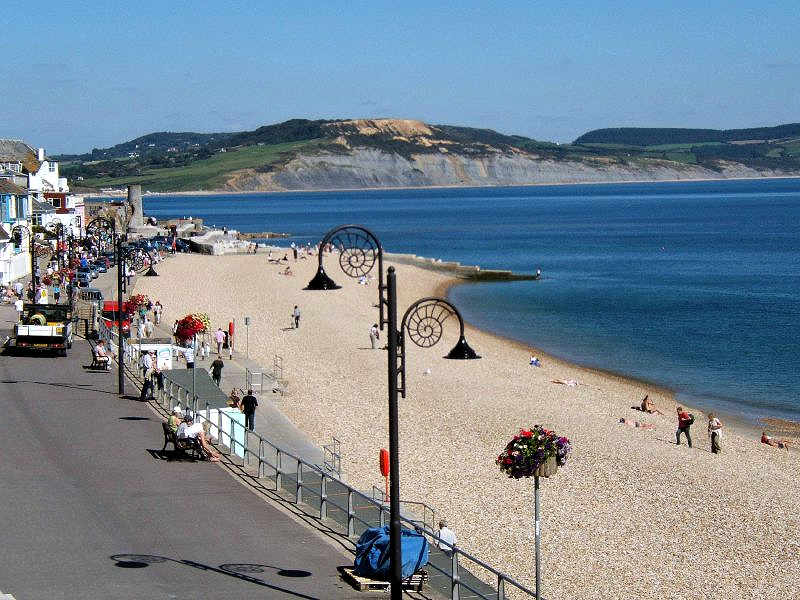
Lyme Regis, Dorset. Lyme Regis is a popular seaside town surrounded by cliffs containing the Blue Lias Formation which is a prime Jurassic fossil hunting location. The Golden Cap near Charmouth is in the background. Notice the ammmonite light poles. Image by: Rictor Norton & David Allen (CC-by-2.0).
Recommended Mary Anning Books:
Jurassic Mary: Mary Anning and the Primeval Monsters
Pierce 2015
There are many biographies about Mary Anning. This one does a great job showing her as an important female pioneer in paleontology. It details the difficulties she had throughout her life and gives intimate details about her and Lyme Regis in the 1800's. Available as Kindle or Paperback.
Dinosaur Lady - The Daring Discoveries of Mary Anning the First Paleontologist
Linda Skeers 2020
A great childrens book about Mary Anning. It is filled with wonderful Illustrations and is great for introducing
your child to paleontology. Available as Kindle or Hardcover.
Additional Images:
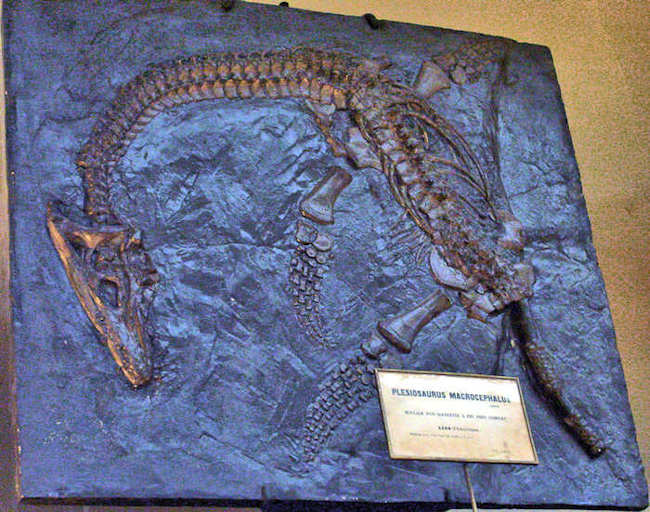
This is the second nearly complete Plesiosaur Mary Annning found. It's a juvenile of a species called Plesiosaurus macrocephalus. This cast is on display at the Museum national d'histoire naturelle, Paris. Credit: FunkMonk (CC-by-SA-3.0)
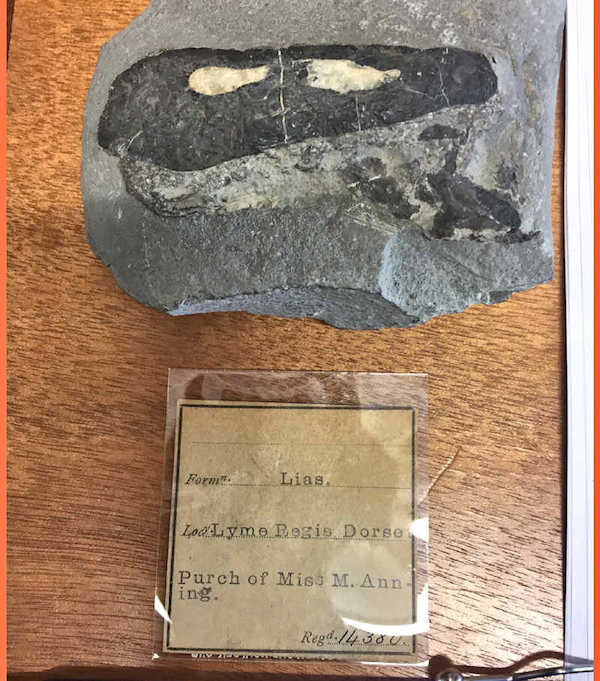
This is a fossilized ink sac found by Mary Anning. It's most likely from a belemnite. Mary Anning would mix fossil ink with water to reconstitute it. She then used the fossil belemnite ink to make drawing of the fossils. This is specimen number PI OR 14380 at the Natural History Museum, London. Image from the digitized collection of the British Museum - Credit: The Trustees of the Natural History Museum, London (CC-by-4.0).
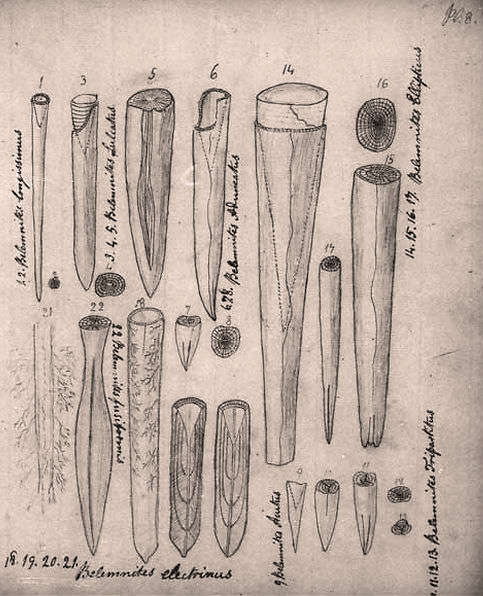
These are drawings of belemnites by Mary Anning. This is from one of the plates in Miller J.S. "Observations on belemnites," Transactions of the Geological Society of London, vol.2 1822. Housed at the British Museum of Natural History.
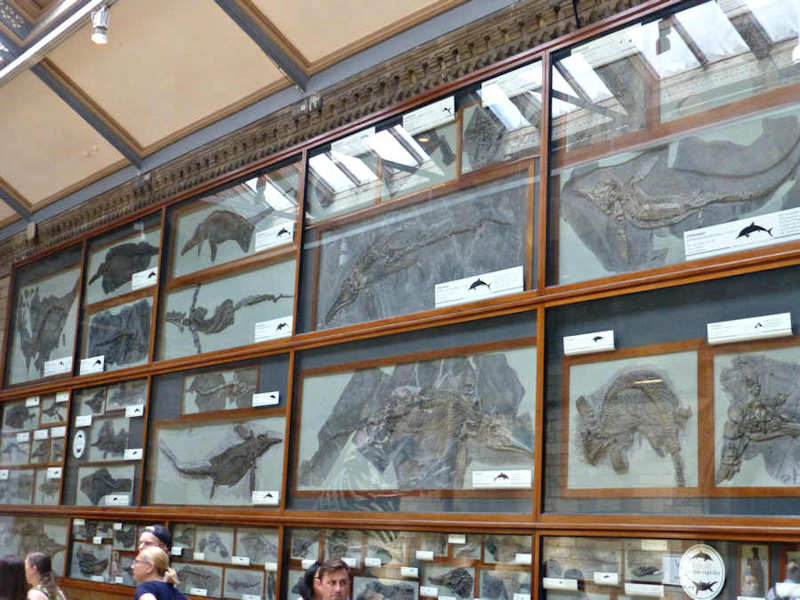
This is part of a wall at the British Natural History Museum, London. This hall of "marine reptiles" contains 100's of ichthyosaur and plesiosaur specimens, many of which were collected by Mary Anning.
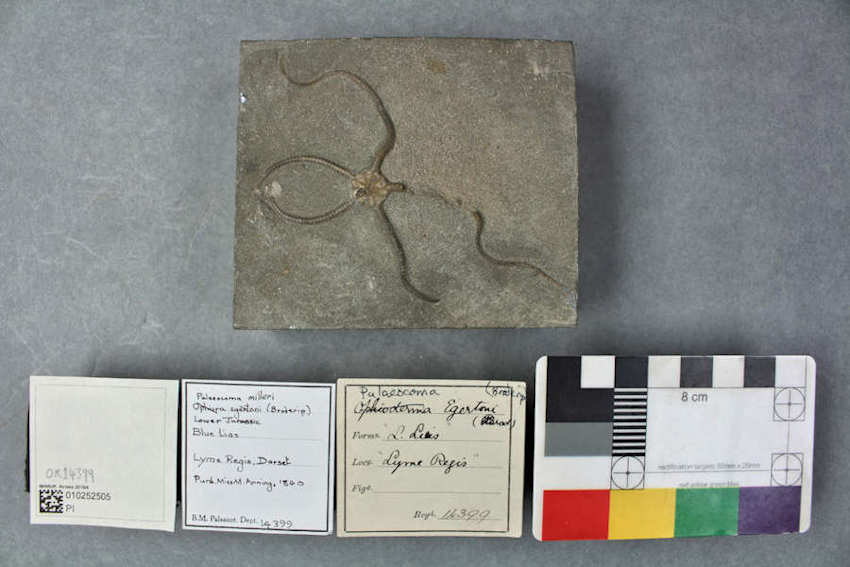
There are more fossils than just marine reptiles and cephalopods at Lyme Regis. Here is a Brittle star that Mary Anning found in 1824. It's a Palaeocoma milleri from the Blue Lias of Lyme Regis. This is specimen number PI OR 14399 at the Natural History Museum, London. Image from the digitized collection of the British Museum - Credit: The Trustees of the Natural History Museum, London (CC-by-4.0).
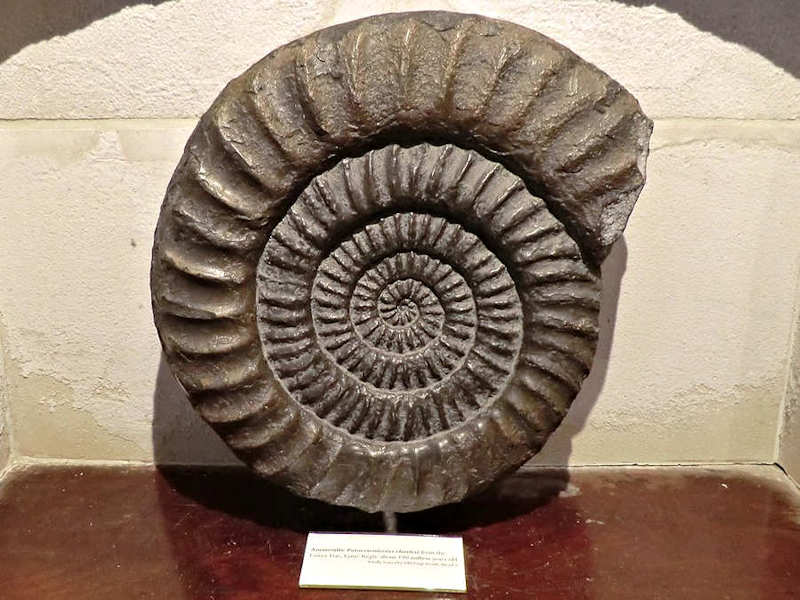
A large ammonite from the Blue Lias on display at the Lyme Regis Museum. Image by: Kmtextor. (CC-by-4.0)
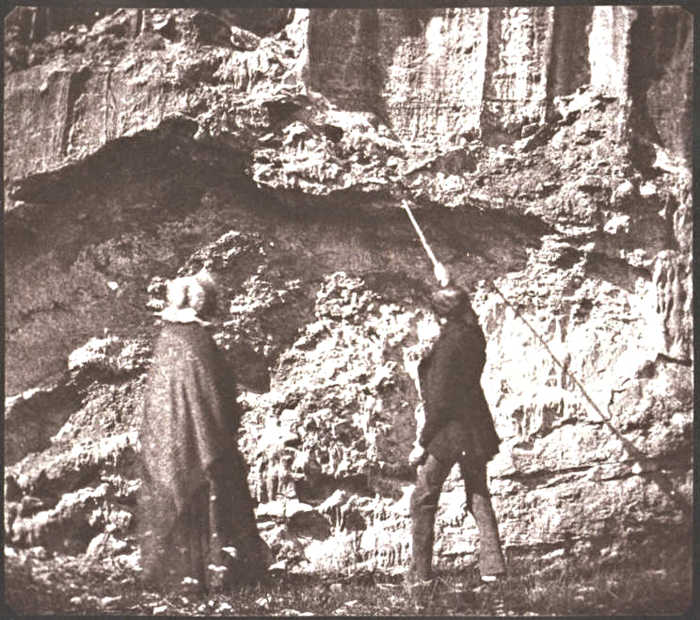
This is an intriguing image titled "The Geologists, Chudleigh, Devon" by William Henry Fox Talbot c. from 1843. Some people refer to the woman in the image as Mary Anning, however, it is not. The image is not taken at Lyme Regis and Talbot did not correspond with Mary Anning. A research paper about this image suggests Talbot used a couple of his friends as props for the photo. Image from the National Media Museum, Bradford, U.K. The research paper about this image can be found here: M.A. Taylor and S. Levitt 2015.
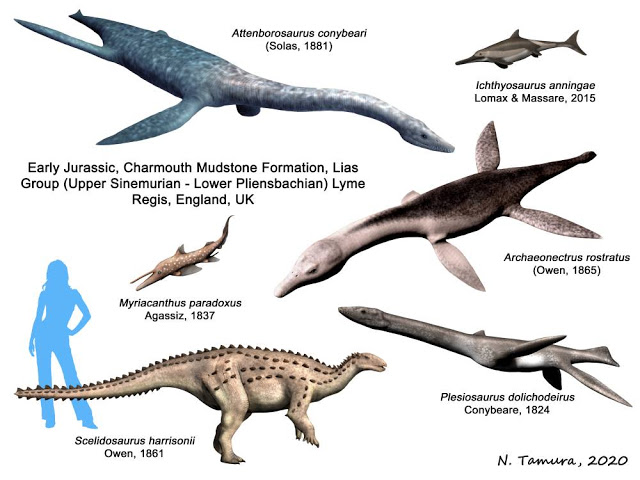
Vertebrate fauna of the Charmouth Mudstone, Lias Group of England, UK. This shows the typical marine vertebrates found in the layers. Notice the Ichthyosaurus at the top left, it's named after Mary Anning. Also, there is one land dinosaur in the fauna. A news article about this interesting dinosaur is here. Image by: Nobu Tamura (CC BY-SA 2.0).
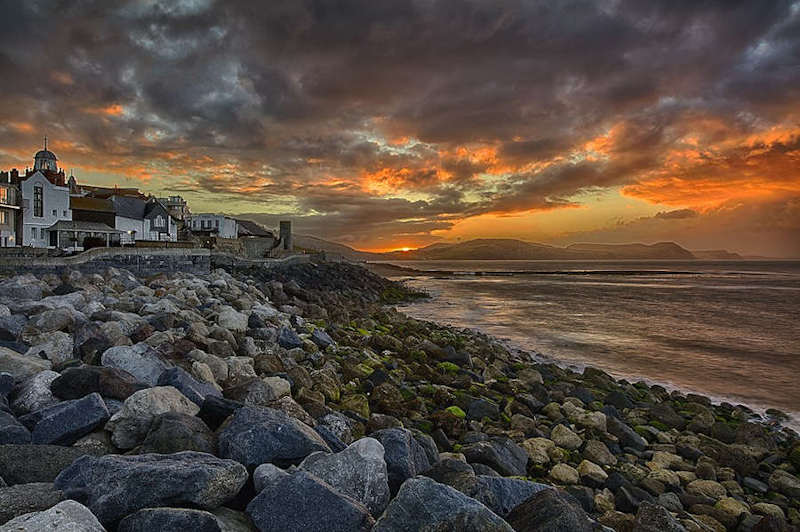
A Long Exposure of Lyme Regis, Dorset. Lyme Regis is surrounded by cliffs containing the Blue Lias Formation which is a prime Jurassic fossil hunting location. Image by: Lies Thru a Lens (CC-by-4.0). )
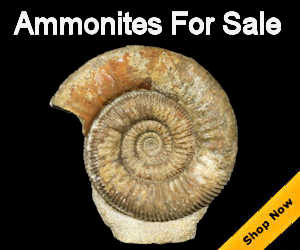
Ammonite Fossils by Fossilera

